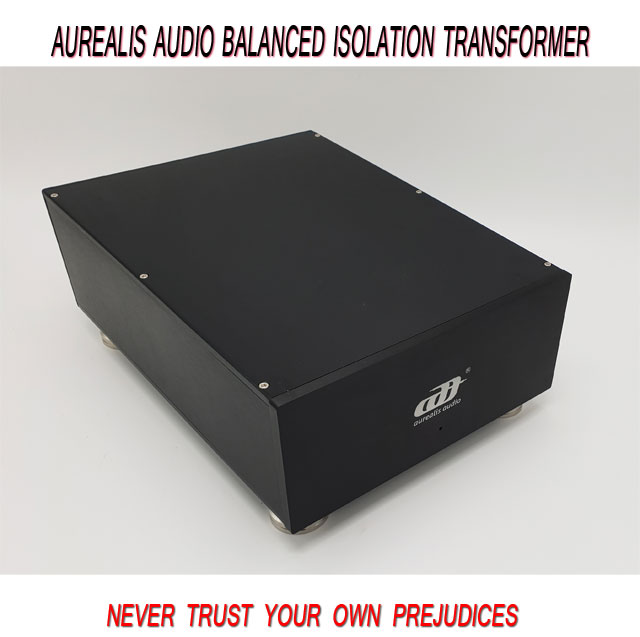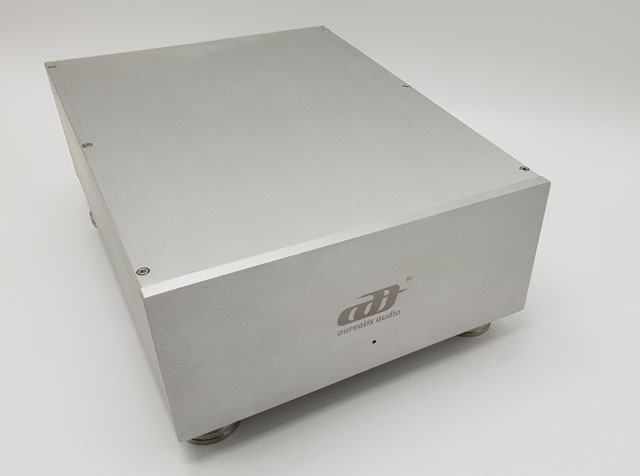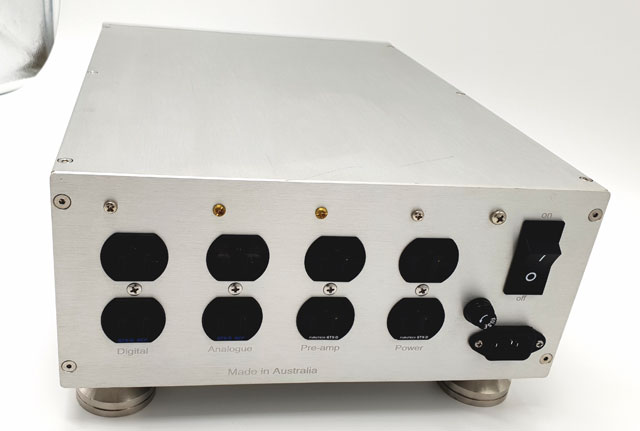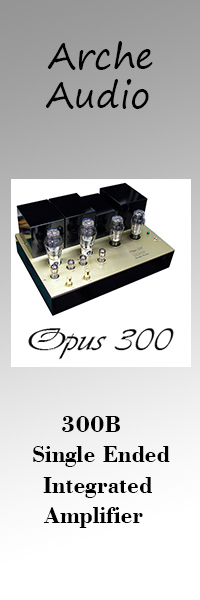AUREALIS AUDIO BALANCED ISOLATION TRANSFORMER

 If you had asked me several weeks ago what piece of equipment would make a big difference in a music system, the words “isolation transformer” would not have escaped my lips. The reason for my reticence on this score arises from my having already tried them before, even one per monoblock for so-called “ultimate isolation”, each transformer a beast weighing over 30kg and capable of swinging a maximum of 2kVa. I did hear some minor improvements, but nothing that would justify the expense and effort of incorporating them into the existing audio ecology. Understandably jaded then, which was why when Robert, the local dealer for an unknown (to me) Australian hifi company called Aurealis Audio got in touch about an isolation transformer that he swore would improve any system, I simply smiled an enigmatic smile and put him off for as long as I could. His persistence eventually won out, and I grudgingly agreed for him to send a unit to me. The plan was to listen for a few days, then pack it up and politely send it back. Ah, talk about prejudices, pre-judgements and preconceived notions.
If you had asked me several weeks ago what piece of equipment would make a big difference in a music system, the words “isolation transformer” would not have escaped my lips. The reason for my reticence on this score arises from my having already tried them before, even one per monoblock for so-called “ultimate isolation”, each transformer a beast weighing over 30kg and capable of swinging a maximum of 2kVa. I did hear some minor improvements, but nothing that would justify the expense and effort of incorporating them into the existing audio ecology. Understandably jaded then, which was why when Robert, the local dealer for an unknown (to me) Australian hifi company called Aurealis Audio got in touch about an isolation transformer that he swore would improve any system, I simply smiled an enigmatic smile and put him off for as long as I could. His persistence eventually won out, and I grudgingly agreed for him to send a unit to me. The plan was to listen for a few days, then pack it up and politely send it back. Ah, talk about prejudices, pre-judgements and preconceived notions.
 Robert delivered the Balanced Isolation Transformer (BIT for short) to me several days later. The moment the unit was switched on and feeding both my source components and a pair of big REL 212 S/E sub-woofers (review to follow), I was forced to throw my preconceptions out of the window. This little BIT – little by the standards of its non-illustrious predecessors – made an immediate and undeniable improvement. It dropped the noise floor to the point where details that were previously masked were now audible, details which I had no idea were even present in the recording. I don’t mean things like an extra triangle tinkling in the background. I am talking about details like the actual timbral qualities of acoustic instruments such as violin, flute, oboe and piano, things that make them sound much more like real instruments instead of just a reproduction thereof. It made it possible for me to enjoy “less well-recorded” LPs, which I had hitherto relegated to the has-been heap, believing them to be dry, uninteresting and poorly produced or pressed. Well, many of them did remain dogs, but quite a surprising number of them actually proved to possess more in their grooves than I previously thought. A good example would be Heifetz’s rendition of Bach’s famous Chaconne on a mono RCA pressing. Without the BIT, the violin sounded thin and screechy. With it, there was still a residual brightness, but there was now enough texture and tone for me to identify a microphone recording a real man playing a real instrument. It was uncanny. Similarly, in Zoltan Kodaly’s “Sonata for Solo Cello” on Nonesuch, the cello was now bold, vivid and colourful, with all the minute details (you know, bow on string, string squeaks, accidental bumps against instrument, stuff that get audiophiles all wet and horny) present and accounted for.
Robert delivered the Balanced Isolation Transformer (BIT for short) to me several days later. The moment the unit was switched on and feeding both my source components and a pair of big REL 212 S/E sub-woofers (review to follow), I was forced to throw my preconceptions out of the window. This little BIT – little by the standards of its non-illustrious predecessors – made an immediate and undeniable improvement. It dropped the noise floor to the point where details that were previously masked were now audible, details which I had no idea were even present in the recording. I don’t mean things like an extra triangle tinkling in the background. I am talking about details like the actual timbral qualities of acoustic instruments such as violin, flute, oboe and piano, things that make them sound much more like real instruments instead of just a reproduction thereof. It made it possible for me to enjoy “less well-recorded” LPs, which I had hitherto relegated to the has-been heap, believing them to be dry, uninteresting and poorly produced or pressed. Well, many of them did remain dogs, but quite a surprising number of them actually proved to possess more in their grooves than I previously thought. A good example would be Heifetz’s rendition of Bach’s famous Chaconne on a mono RCA pressing. Without the BIT, the violin sounded thin and screechy. With it, there was still a residual brightness, but there was now enough texture and tone for me to identify a microphone recording a real man playing a real instrument. It was uncanny. Similarly, in Zoltan Kodaly’s “Sonata for Solo Cello” on Nonesuch, the cello was now bold, vivid and colourful, with all the minute details (you know, bow on string, string squeaks, accidental bumps against instrument, stuff that get audiophiles all wet and horny) present and accounted for.
But the true party piece of the BIT, the thing that makes it stand out and continue to astonish me, is how it expands my soundstage. Pre-BIT, the stage width ended at the extremes of the drivers. Now, it is literally wall-to-wall. When I close my eyes, I cannot hear the drivers as easily as I could before, which means that imaging has concomitantly improved to the point where I am now honestly able to claim that my loudspeakers “disappear”. In my small room at least, the Voxativ Ampeggios are not the easiest transducers to make invisible, but somehow the BIT manages it with aplomb, and does so for disc after disc. How it accomplishes this feat is way beyond my mortal powers of comprehension.
 One of the things I love about my current system is how difficult it is for me to focus on anything else when a record is playing. No reasonable amount of reading, daydreaming, or extended stream-of-consciousness mind-wandering is possible. The music compels you to listen and listen deeply you do. The BIT amplifies this effect by at least another 20-30%, which is another amazing feat. The wall-to-wall soundstage helps, as does the added realism it brings to the proceedings. I don’t hear greater depth to any notable degree, but I will swear on my best pair of trousers that, on certain discs with well-recorded low frequency information, and the recording suddenly surprises with a huge kick out of nowhere, I am able to reliably place bass and percussive instruments further back into a more cavernous soundstage. Previously, bass sounds would simply billow out into the room without much in the way of imaging information. A lot of credit should be laid at the feet of the REL subwoofer pair, naturally. But remember, the BIT feeds them juice and keeps them going.
One of the things I love about my current system is how difficult it is for me to focus on anything else when a record is playing. No reasonable amount of reading, daydreaming, or extended stream-of-consciousness mind-wandering is possible. The music compels you to listen and listen deeply you do. The BIT amplifies this effect by at least another 20-30%, which is another amazing feat. The wall-to-wall soundstage helps, as does the added realism it brings to the proceedings. I don’t hear greater depth to any notable degree, but I will swear on my best pair of trousers that, on certain discs with well-recorded low frequency information, and the recording suddenly surprises with a huge kick out of nowhere, I am able to reliably place bass and percussive instruments further back into a more cavernous soundstage. Previously, bass sounds would simply billow out into the room without much in the way of imaging information. A lot of credit should be laid at the feet of the REL subwoofer pair, naturally. But remember, the BIT feeds them juice and keeps them going.
All this forced to look at the label again more closely. Who is Aurealis Audio again?


PROVENANCE & CONSTRUCTION
They are, as intimated earlier, an Australian company located in Brisbane, and specializes in high quality accessories for the discerning gentlema… er, audiophile. As an example, they fabricate their own cables to their own exacting specifications using such available materials as Duelund wire and ETI Research connectors. Robert assures me that they did not settle on these raw materials by chance, but after conducting vigorous experimentation with different brands and exhaustive listening tests of their own. The BIT represents their first foray into electronic components, albeit still peripheral in nature.
Proudly made by Antipodean hands, the BIT is (to me at least) a handsome block of brushed aluminium with four duplex American outlets at the back, marked “Digital”, “Analog”, “Pre-amp” and “Power” respectively. The top and base plates are solid aluminium, machined to an even 8mm thickness. Before mounting the gigantic heart of the beast, the 2kVa transformer, Aurealis employs a triple iso-acoustics solution to shield it from all manner of external mechanical interference including stray vibrations, but the details of this solution is proprietary knowledge. From the transformer, the raw power then goes through a large 30A filter that is claimed to reduce noise by as much as 60dB. On top of that, all internal wiring is Ohno Continuous Casting copper and rated for up to 25A, the former for preserving the music’s micro details while the latter to ensure no dynamic restriction. In addition, all internal wiring going to the outlets are first cryogenically treated and then loaded with special compounds (again the nature of which remains proprietary information) which are the fruit of their extensive experimentation, and which Aurealis claims will result in more natural reproduction of sound from connected components.
In use, I had a Purepower 2000 AC regenerator plugged into the Analog outlet feeding my source equipment, while both the active REL subwoofers were fed from the Power outlet via a separate power strip. Aurealis has laid-out the BIT in such a way as to completely isolate the outlets from each other, and the digital and analog outlets themselves are high-quality rhodium-plated NCF (Nano Crystal Formula) units from Furutech. The grounding layout was also given the same careful ministrations; all ground wire is OCC silver and star-wired to a silver-plated ground board. All things considered, it is now possible for me to understand why they are asking USD2800 for each unit RRP. You may not be able to find a dealer in your state – yet. But you will be able to order this and have it delivered to you via their website www.aurealisaudio.com.au
CONCLUSION
This review has taught me two things: first, never trust your own prejudices, even if they were informed by personal experiences. Second, I will not be able to live without the Aurealis Audio BIT. It has proven to be so much more than the sum of its own parts, or indeed the sum of its theoretical functions. I have never heard an isolation transformer do what this thing does, and in a package that has both a relatively small footprint, and is finished as well as any high-end amplifier you care to name.
One caveat: my sample came with an intermittent low-level buzzing, like a slightly bad-tempered bumble bee, which was audible even from my listening position. The buzz is inaudible though when the music is playing. Still, it is cause for annoyance especially when I am used to a quiet room when the system is completely turned down or off. I could imagine that it may be a deal-breaker for those of us whose sensitivities do not allow for the tolerance of the same. To be fair, Robert came with a tech to fix and tighten everything in the unit, but the buzzing remained. It may be just a slightly noisy unit that I have, or it could also be DC offset going from my wall into the BIT which can cause such mechanical hum.
Still, I consider the BIT an amazing product. Its asking price, though not cheap, is commensurate with the distinct enhancements it will bring to your system. If you decide to buy it, you may suffer from sticker shock for about 10 minutes, after which you will forget about the money and congratulate yourself for being a smart, discerning gentlema…er, audiophile. If this is what they can do with an isolation transformer, I cannot wait to hear what else Aurealis Audio might offer in future.

Stephen Yan
Specifications:
Price $2800 USD.
High Quality Ring core 2KVA balance Isolation transformer
1:1 ratio 235V to 235V.
Features – Soft Starts and pre noise filter
Total 2 sets of Duplex GTX-D(G) Receptacle outlets , 2 sets of GTX-D NCF (R) Receptacle outlets
Cable are Cryogenic treated OCC of handlng current of 25A
Silver Ground Block , and Fine tune with OCC silver grounding cables
Furutech IEC Inlet
Dims ; 300mm (Width), 400mm (Depth ), 130mnm (height)
The equipment rest on Aluminum Spikes
Weight – 18kg
Stereo Times Masthead
Publisher/Founder
Clement Perry
Editor
Dave Thomas
Senior Editors
Frank Alles, Mike Girardi, Russell Lichter, Terry London, Moreno Mitchell, Paul Szabady, Bill Wells, Mike Wright, and Stephen Yan,
Current Contributors
David Abramson, Tim Barrall, Dave Allison, Ron Cook, Lewis Dardick, John Hoffman, Dan Secula, Don Shaulis, Greg Simmons, Eric Teh, Greg Voth, Richard Willie, Ed Van Winkle, Rob Dockery, Richard Doran, and Daveed Turek
Site Management Clement Perry
Ad Designer: Martin Perry






Be the first to comment on: AUREALIS AUDIO BALANCED ISOLATION TRANSFORMER